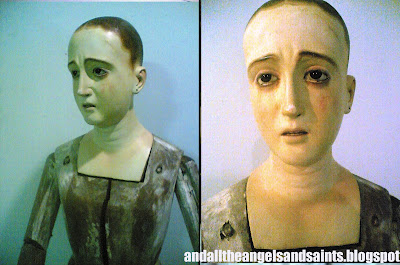The idea of buying antiques from a Philippine online shop is unthinkable for many, because assessing their authenticity can be tricky just by looking at photos—you can’t touch a santo, feel its weight, inspect its real condition. You also have to deal with reproductions, dubious fakes, and scammers!
But there are times when nice, genuine santos pop up every now and then on online sites run by reputable sellers, piquing my interest. One such example was this Recoleto SAN NICOLAS DE TOLENTINO wooden figure standing on an ochovado base, found on FB Marketplace.
Recoleto santos are among my favorite collectibles because my “pueblo” was actually evangelized by Recollect saints. Of the 4 provinces of the Recollect Order, one is named as the Province of San Nicolas de Tolentino, created in 1621. Seven friars, led by Fray Andres San Fulgencio first came to the future Mabalacat in 1711, and found a forest settlement inhabited by a community of Aetas, headed by one named Garagan. The saint also holds a special meaning to me as a Kapampangan since the renown pasalubong biscuit from Pampanga was named after him--“saniculas”.
The seller sent me more pictures for my perusal, and I was told that it had come from Panay. The 14 inch. San Nicolas reminded me of some Puerto Rican santos where the carving tends to be sharp and angular, with unsmoothed edges and corners, as evidenced by the chiselling of the drapes on the santo’s habit, fingers, sandals, and the 8-sided base.
The Recollect belt clearly identifies the santo, who, a one point must have held his attributes, now missing—a dish on where a dying partridge bird rested which he miraculously revived upon feeding from his plate. His right had would have held a crucifix garlanded with lilies, to symbolize his purity. This particular hand is an obvious replacement as it was disproportionately bigger than the left.
There
are rectangular patches of gold-leafing in his black habit. The painter
probably intended to cut and shape these gold patches into stars, which are
also his emblems. Legend has it that stars guided him to Tolentino, near
his place of birth.
Paint flaking was noted on the base, and the face of the santo. There was a hairline crack running from the waist to the hem of the santo’s habit which has started to open.
After carefully assessing the condition of this folk santo, I decided to complete it by reconstructing its missing elements. But before I could do that, I had to attend to the more pressing concerns:
First, I filled the hairline crack with plastic wood, which was like a wood putty with the consistency of glue, used in repairing flaws on wood.
Once hardened, the crack was sealed and the filling was painted black. The paint losses on the face and the base were fixed with acrylic paints.
Now, I could go to replacing the missing attributes. First—the missing halo. This was supposed to be the easiest to do, since I keep all sorts of old metal santo accessories, but it turned out the round, brass halos I have are so big.
Then I remembered a pair of round, calado earrings that I wisely bought from a tiangge years before—because they reminded me of santo halos!! So I just added a wire in the center to form an umbrella type of halo, called “paragua”, that I stuck into a ready-made hole on the top of the santo’s head
A plain wooden cross would have been an acceptable replacement for the santo’s missing crucifix. But I found a tiny wooden crucifix with the metal corpus of Christ and aluminum cantoneras that was actually a remnant of a rosary. I just shaped the end so that it could fit into the grasp of the santo’s hand.
The
miniature bird on the platter was more challenging to recontruct. The plate was
fashioned from a metal cap (tansan) that I flattened with a hammer. To
remove the rubber seal and the brand name ( I used a Red Horse tansan!),
I just heated the crown until it looked blackened with age. The “plate” was
then pegged on the open left palm of the figure. I ran thru some 5 tansans
before I was satisfied with the result.
I have saved the bird for last, because I know this would give me a hard time, To be true to the wooden figure, I attempted to carve a bird, no more than a quarter of an inch long, using balsa wood. But the wood kept on cracking even when I was using an Exacto knife. I gave up after 2 tries.
Then, I came up with the idea of molding a small bird from plastic wood I used before. I thought it would turn clay-like when it’s drier, but the shape did not hold. Then I tried papier mache, using fine paper pulp from tissue paper and white glue—the result was a sad-looking lump, not a bird.
Finally, I called on a lifeline—a friend and an artist who made miniature dioramas. How could I forget Dodjie Aguinaldo! So, based on my instructions, he made me a miniscule quail (pugo) bird, hand-molded from air-dried clay, just 1.5 cm. long. I just painted it after, lacquered it, and set it on top of the tansan plate—a perfect fit!
As a
finishing touch, I found an old cast-iron, patinated salvage, once part of a
decorative applique for a door, perhaps. I nailed it on the front of the base
to make it look remotely like a carroza frontal.
With his completion, SAN NICOLAS DE TOLENTINO, patron of souls in purgatory, has just become my favorite Recollect in my santos grouping which I fondly call my “Re-Collection.”
MANY THANKS TO:
























.jpg)
.jpg)



.jpg)

.jpg)


.jpg)

















.jpg)


